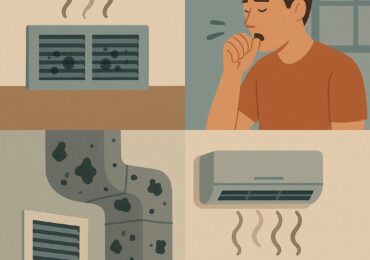Mold can quietly grow inside a central air system, spreading through ducts and vents before anyone notices. It often starts in damp areas where moisture collects, such as around coils or drip pans. As the system circulates air, those hidden spores can move into every room, affecting comfort and air quality. Recognizing the early warning signs of mold buildup helps prevent damage to the system and protects indoor health.
A central air system should keep a home comfortable, not cause musty smells or allergy flare-ups. However, small signs often point to a growing mold problem. Learning what to look for allows homeowners to act fast, maintain cleaner air, and avoid costly repairs later.
Musty or moldy odor coming from vents
A musty or moldy smell from air vents often signals moisture trapped inside the ductwork. This damp environment allows mold spores to grow and spread through the system. The odor usually becomes stronger when the air conditioner or heater runs, pushing the smell into every room.
Mold buildup may start in areas that collect condensation, such as coils, drain pans, or insulation near vents. Dust and debris can trap moisture, which supports further growth. Therefore, regular inspection helps detect early signs before the problem worsens.
If cleaning filters and ducts does not remove the smell, the system may need deeper treatment. In such cases, homeowners can contact professional HVAC mold cleaning services to remove mold safely and restore clean airflow.
Ignoring the odor can lead to poor indoor air quality and recurring moisture issues. Addressing it quickly helps maintain a healthier and more efficient central air system.
Increased allergy-like symptoms among occupants
Mold buildup in a central air system often leads to allergy-like symptoms among people inside the home. Occupants may notice more coughing, sneezing, or nasal congestion after the air conditioner runs. These symptoms can appear mild at first but may worsen with continued exposure.
People with asthma or other breathing problems may feel more discomfort. The spores that move through the vents can irritate the airways and cause wheezing or shortness of breath. Even those without allergies might develop itchy eyes or sore throats over time.
A sudden rise in allergy complaints from several household members can signal hidden mold growth. If symptoms ease once the system is off or after leaving the building, the air ducts could be the source. Regular inspection and cleaning help reduce this risk and keep indoor air healthier.
Visible black or green spots on ductwork or vents
Visible black or green spots on air vents or ductwork often indicate mold growth. These spots may appear on vent covers, ceilings, or the edges of ducts. They can look like dirt or dust at first, but closer inspection often reveals a fuzzy or slimy surface.
Mold tends to grow in damp or humid areas where condensation collects inside the system. Leaks, poor ventilation, or high indoor humidity can create conditions for the moisture mold to spread. Therefore, spotting discoloration near vents may signal moisture problems inside the ducts.
In addition, mold can appear in different colors, such as black, green, or gray. Each color may point to various types of mold, but all can affect indoor air quality. Homeowners should avoid touching visible mold and schedule a professional inspection to confirm the cause and decide on safe cleaning steps.
Excess moisture or condensation around AC components
Excess moisture around air conditioning parts often signals a drainage or leak issue. Water may pool under the indoor unit or appear as damp spots on nearby walls or floors. These wet areas can damage surfaces and create the right conditions for mold to grow inside the system.
Condensation naturally forms as the AC cools warm air. However, too much water suggests that the condensate pan or drain line may not move water out properly. A clogged drain or damaged line can cause overflow and lead to ongoing moisture buildup.
Visible water streaks, rust on metal parts, or musty odors near vents often point to hidden moisture. These signs show that air circulation or drainage may not work as designed. Addressing the issue early helps prevent mold spread and keeps the system operating efficiently.
Reduced airflow or unusual system noises
Reduced airflow often signals a blockage or buildup inside the ductwork. Dust, mold, or debris may restrict air movement, causing rooms to feel uneven in temperature. As a result, the system must work harder to push air through, which can raise energy use and reduce comfort.
Unusual noises also point to possible mold or moisture issues inside the system. A rattling or whistling sound may come from clogged vents or damp areas that affect moving parts. These sounds often appear before visible mold growth becomes noticeable.
In addition, a musty odor may accompany the noise or airflow problem. This smell usually indicates trapped moisture or mold inside the ducts or coils. Addressing these early signs helps prevent larger air quality problems and keeps the system running efficiently.
Conclusion
Mold buildup in central air systems often starts quietly but can cause health and air quality issues if ignored. Recognizing early signs such as musty odors, visible spots near vents, or increased allergy symptoms helps prevent larger problems later.
Regular inspection and cleaning reduce the chance of mold growth. Homeowners should check filters, drain pans, and ductwork for moisture or dirt that may support mold.
Professional maintenance also helps detect hidden mold and keeps the system running efficiently. Addressing small issues early saves money and protects indoor air quality.
